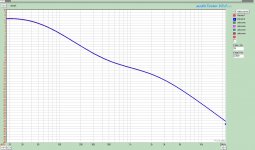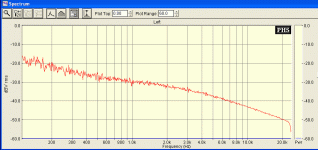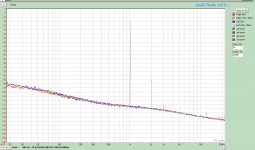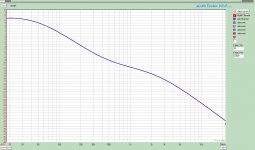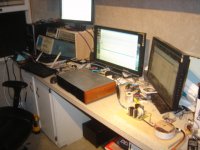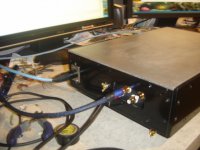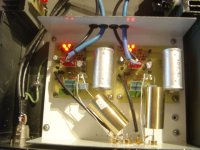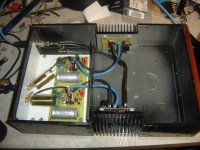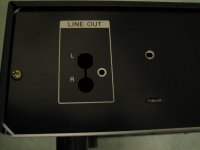😀his name by the way is toast. We have a second cat named spare.
Persuasive. Listen for 10mins just to catch the general tone then.
Will Test in a few. This is the RIAA curves at .30mV. They appear to have shifted upward. Red is Version 1 pc board and Red is Version 2. They are even more identical than before.
I will listen to it. I just threw the cat out and told it to catch dinner.
I will listen to it. I just threw the cat out and told it to catch dinner.
Attachments
Listening to Amanda McBroom (Sheffield Recording) Love Letters and Amanda and if the curve is off it isn't by much.
Tonal quality has improved greatly. Bass is more present and natural, HF details and dynamics much improved. Fluid and musical.
Tonal quality has improved greatly. Bass is more present and natural, HF details and dynamics much improved. Fluid and musical.
The time constants you got, the same I use. See, minimum gremlins, maximum joy. The Teflon ain't weird after all, just open.
Hello All,
4563 posts is a gob. I went digging through this thread looking for a summary of the good stuff and I found a summary PDF document, with a parts lists and schematics , called “Salas Simplistic NJFET Buffered RIAA Version 1.0” is this the most current or is there an updated version? When it starts to get cold and wet out I want to build this thing.
DT
All just for fun!
4563 posts is a gob. I went digging through this thread looking for a summary of the good stuff and I found a summary PDF document, with a parts lists and schematics , called “Salas Simplistic NJFET Buffered RIAA Version 1.0” is this the most current or is there an updated version? When it starts to get cold and wet out I want to build this thing.
DT
All just for fun!
Hi DT, what's up? That PDF you got its good but a bit long in the tooth for some better tunings. When you will have some enough Jfets and having noted down your pairs, you will tell me about those, and about the cart to use, plus system gain and I will give you best values circuits. Its not easy to make a low noise high gain circuit perfect on first shot, but all made it in the end. Its SE no loop feedback and has its precision care demands also.
Hi DT, what's up? That PDF you got its good but a bit long in the tooth for some better tunings. When you will have some enough Jfets and having noted down your pairs, you will tell me about those, and about the cart to use, plus system gain and I will give you best values circuits. Its not easy to make a low noise high gain circuit perfect on first shot, but all made it in the end. Its SE no loop feedback and has its precision care demands also.
Hello Salas,
Just got out of the pool after swimming the daily half mile. I have ordered 2SK170BL’s from futurlec.com I also have current and voltage panel meters to assemble a test jig for LED and JFET testing. There will be pairs.
Thank you for the offer, I will send along the pair data (when I get it) and cartridge information.
It looks like you know low noise!
DT
All just for fun!
DT, this is a worth while build. I learned more on this build, thanks to Salas et. al. than I have on any other build. Especially in the measureing department. Precision is critical. The results are spectacular.
I will share my final graphs for a while, as I am going to listen now. Both channels are now version 2 of the pc board. The transformer and PS Filter are mounted on an external breadboard till I make a chassis.
Plots are 1Vrms = 0dBs.
Left = Blue Right = Red.
0mV and 0.3mV 1kHz
RIAA response graph. (Could not get more matched)
Also threw a few photos of my sanctuary. Needs a cleaning now.
P.S. If you notice the chassis is almost empty now.... Enough room for a version 1.2 Shunt Regulator😉
I will share my final graphs for a while, as I am going to listen now. Both channels are now version 2 of the pc board. The transformer and PS Filter are mounted on an external breadboard till I make a chassis.
Plots are 1Vrms = 0dBs.
Left = Blue Right = Red.
0mV and 0.3mV 1kHz
RIAA response graph. (Could not get more matched)
Also threw a few photos of my sanctuary. Needs a cleaning now.
P.S. If you notice the chassis is almost empty now.... Enough room for a version 1.2 Shunt Regulator😉
Attachments
DT, this is a worth while build. I learned more on this build, thanks to Salas et. al. than I have on any other build. Especially in the measureing department. Precision is critical. The results are spectacular.
I will share my final graphs for a while, as I am going to listen now. Both channels are now version 2 of the pc board. The transformer and PS Filter are mounted on an external breadboard till I make a chassis.
Plots are 1Vrms = 0dBs.
Left = Blue Right = Red.
0mV and 0.3mV 1kHz
RIAA response graph. (Could not get more matched)
Also threw a few photos of my sanctuary. Needs a cleaning now.
P.S. If you notice the chassis is almost empty now.... Enough room for a version 1.2 Shunt Regulator😉
Excellent. You wouldn't wait for the R-Core after all.🙂
*You could try those filter curves taken without the correction file too. Not sure how they tie when the card goes at low dB. If they were plus 1dB off in the highs it would have been subjectively very annoying too. You should centre the curves on the plot at 1kHz not 20Hz, as well. They normally deviate both sides edges where the card wimps out a bit.
R core will fit perfectly well in the PSU enclosure. I didn't want to split the chassis initially as I was waiting for the Ultimate RIAA to do that with. This is pretty close, I won't be shopping for a while.
Listening to a 1/2 Mastered version of Weather Report 8:30 live from Tokyo. I am about in the 5th row center. The sax was walking across the stage during a solo.
The system is pretty flat from about 20 to 20k with the MAudio. Another reason I stayed with it.
Listening to a 1/2 Mastered version of Weather Report 8:30 live from Tokyo. I am about in the 5th row center. The sax was walking across the stage during a solo.
The system is pretty flat from about 20 to 20k with the MAudio. Another reason I stayed with it.
Some vinyl through this contraption can be quite eerie sometimes. I have some Zappa with the London Symphony, can take you aback.
I didn't want to split the chassis initially as I was waiting for the Ultimate RIAA to do that with. This is pretty close, I won't be shopping for a while.
You look keen on it, so put a brick where the toroid was, run in the cart a bit by going through some great vinyl performances, play with the TT and arm set up along the way. Now the teaser line: V1.2s open it up 20% further when conservatively speaking. OK I am off now! 😀
The Measureing Department
Hello,
The measuring department is half the attraction. I have a new to me bench courtesy of UC Davis surplus store, Pete Millett sound card interface, computer and Audio Tester 3.0 ready to go.
This seems like the project and good people to develop the tools and skills with.
I just swapped out metalized PP capacitors in the tube line buffer for Russian NOS Paper In Oil. Take Five never sounded so good!
DT
All just for fun!
Hello,
DT, this is a worth while build. I learned more on this build, thanks to Salas et. al. than I have on any other build. Especially in the measureing department. Precision is critical. The results are spectacular.
Also threw a few photos of my sanctuary. Needs a cleaning now.
The measuring department is half the attraction. I have a new to me bench courtesy of UC Davis surplus store, Pete Millett sound card interface, computer and Audio Tester 3.0 ready to go.
This seems like the project and good people to develop the tools and skills with.
I just swapped out metalized PP capacitors in the tube line buffer for Russian NOS Paper In Oil. Take Five never sounded so good!
DT
All just for fun!
Nicoch46 so where did your line-out go? Is it now wireless;->
Salas,
Would my current set-up with the now seperated PS benefit from a small buffer Cap on the shunt reg? I was thinking like a 4.7uF PP on the 52V DC in?
Salas,
Would my current set-up with the now seperated PS benefit from a small buffer Cap on the shunt reg? I was thinking like a 4.7uF PP on the 52V DC in?
- Home
- Source & Line
- Analogue Source
- Simplistic NJFET RIAA
